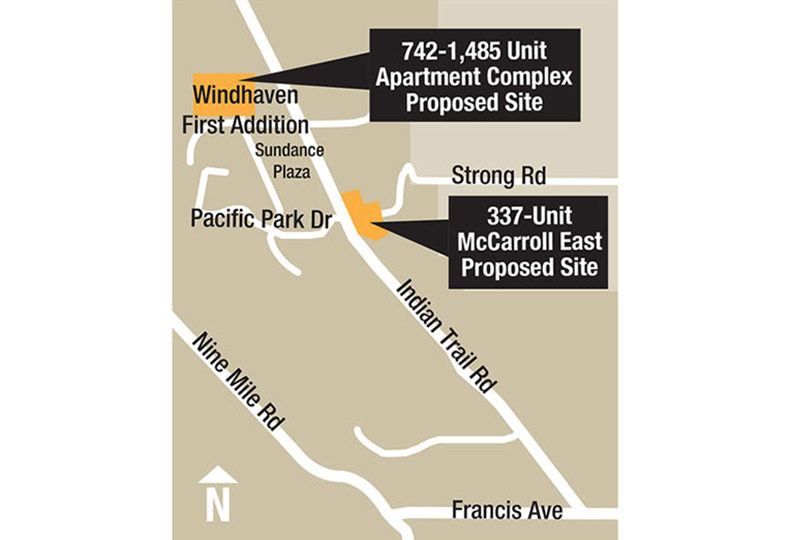
Home » Huge Indian Trail projects eyed
Huge Indian Trail projects eyed
Potential 1,800 living units raise worries about traffic

February 11, 2016
Two developers are asking the city for comprehensive land-use plan amendments that would enable them to build potentially more than 1,800 dwelling units combined in the Indian Trail area, raising concerns about traffic congestion in the northwest Spokane neighborhood, says Tirrell Black, an assistant planner with the city.
In one request, Spokane developer Harley Douglass, of Morning Side Investments LLC, is seeking a land-use change that would allow up to 30 living units per acre on 50 acres of land in the Windhaven First Addition subdivision.
Douglass couldn’t be reached for comment.
The subdivision is north of Barnes Road, about 320 yards west of Indian Trail Road, and directly west of the Lusitano Apartments complex, which Morning Side developed in 2006.
The Windhaven application says the request would provide a housing density of 742 to 1,485 units for the entire site.
“It is likely the actual unit count will be closer to the lower end of this range,” the application says.
The land use currently is designated for up to 10 single-family and two-family residential units per acre.
In the other comprehensive plan amendment application, Dennis Crapo, owner of Diamond Rock Construction Inc., of Spokane Valley, is requesting a land use change that would allow up to 20 dwelling units per acre on 27 acres of land in the McCarroll East subdivision east of Indian Trail Road, on both the north and south sides of Strong Road.
The land is mostly vacant except for 63 single-family homes.
If approved, the requested land-use designation of two-family residential would allow up to 337 additional living units. Two-family residential allowed uses include duplexes, townhomes, and row houses.
Diamond Rock recently constructed the 96-unit Indian Trail Apartments at 4915 W. Barnes Road.
Black says both applicants have been asked by the city of Spokane to conduct traffic studies, which are expected to be completed later this spring.
The Windhaven application estimates the average number of daily vehicular trips that would be generated by the development could range between 4,900 and 8,000 per day, and the McCarroll application estimates that development would generate 3,800 average daily trips.
Black says the traffic studies also will include a section of Francis Avenue in the area of its junction with Indian Trail Road.
The city then will seek public comment on the requests, and the plan commission will conduct a public hearing and forward recommendations to the City Council.
Black says that even though the requests are in early stages of the comprehensive plan amendment process, she’s received a deluge of comments from Indian Trail neighborhood residents. She says the biggest concerns are related to traffic and access limitations in the area.
She says she has placed 170 people on the interested-persons lists regarding the requests, “so we can notify people more effectively as we move through the process.”
Infrastructure for the Windhaven subdivision, including private streets, water and sewer pipe systems, and electrical, gas, and phone utilities, has already been constructed to accommodate 286 single-family homes, although the homes themselves haven’t been constructed since a preliminary plat for the subdivision was approved a decade ago.
“The intent is to construct wood-framed multifamily buildings in lieu of single-family dwellings … with as little disruption to the existing facilities as possible,” the application says.
The Windhaven application asserts the city’s comprehensive land-use plan should encourage multifamily residential uses near neighborhood centers, such as the Sundance Plaza shopping center, which is within walking distance south of the subdivision.
“The proposal would contribute to the quality of life in this area by supplementing existing underutilized family housing developments in the area,” the application says.
Ed Hume, a consultant on the McCarroll application, says his client was unaware of the much larger Windhaven application when preparing the McCaroll comprehensive plan-amendment request.
Hume says the city is required under growth-management regulations to consider whether the infrastructure is adequate for proposed uses. If infrastructure is deficient, the city is obliged to consider a cure, he claims.
“This is a classic example of where the city fumbled from the get-go on a focused-growth plan,” he asserts. “The city has had 15 years to plan Indian Trail Road. You can’t adopt a plan to accommodate focused growth and then say you’re not ready for it.”
Latest News Real Estate & Construction Government
Related Articles
Related Products




![Brad head shot[1] web](https://www.spokanejournal.com/ext/resources/2025/03/10/thumb/Brad-Head-Shot[1]_web.jpg?1741642753)
